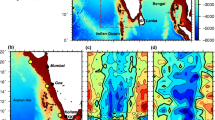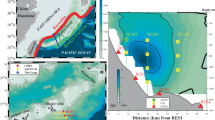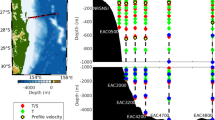Abstract
Using a year-long moored array of current meters and well-sampled synoptic sections, we define the variability and mean structure and transport of the Agulhas current. Nineteen current meter records indicate that time scales for the temporal variability in the alongshore and offshore velocities are 10.2 and 5.4 days, respectively. Good vertical correlation exists between the alongshore or onshore velocity fluctuations, excluding the Agulhas Undercurrent. The lateral scale for the thermocline Agulhas current is about 60 km and the onshore velocity correlations are positive throughout the Agulhas Current system. Mean velocities from the array determine that the offshore edge of the Agulhas Current lies at 203 km and the penetration depth is 2200 m offshore of the Undercurrent. Hence, daily averaged velocity sections, determined by interpolation and extrapolation of current meter locations, for a 267-day period, from the surface to 2400 m depth and from the coast out to 203 km offshore encompass the main features of the Agulhas Current system. The Agulhas current is generally found close to the continental slope, within 31 km of the coast for 211 of 267 days. There are only five days when the core of the current is found offshore at 150 km. Total transport is always poleward, varying from −121 to −9 Sv, with maximum transport occurring when the core is 62 km from the coast. Average total transport for the 267 day period is −69.7 Sv; the standard deviation in daily transport values is 21.5 Sv; and the mean transport has an estimated standard error of 4.3 Sv. The Agulhas Undercurrent, which hugs the continental slope below the zero velocity isotach, has an average equatorward transport of 4.2 Sv, standard deviation of 2.9 Sv and an estimated standard error of 0.4 Sv. Transports from the moored array are in reasonable agreement with transport results from synoptic sections. Based on time series measurements at about 30° latitude in each ocean basin, the Agulhas Current is the largest western boundary current in the world ocean.
Similar content being viewed by others
References
Beal, L. M. (1997): Observations of the velocity structure of the Agulhas Current. Ph.D. Thesis, Department of Ocea-nography, University of Southampton, 158 pp.
Beal, L. M. and H. L. Bryden (1997): Observations of an Agulhas Undercurrent. Deep-Sea Res. I, 44, 1715–1724.
Beal, L. M. and H. L. Bryden (1999): The velocity and vorticity structure of the Agulhas Current at 32°S. J. Geophys. Res., 104, 5151–5176.
Bingham, F. M. and L. D. Talley (1991): Estimates of Kuroshio transport using an inverse technique. Deep-Sea Res., 38(Suppl.), S21–S43.
Bryden, H. L. (1976): Horizontal advection of temperature for low-frequency motions. Deep-Sea Res., 23, 1165–1174.
Bryden, H. L. and L. M. Beal (2001): Role of the Agulhas Current in Indian Ocean circulation and associated heat and freshwater fluxes. Deep-Sea Res. I, 48, 1821–1845.
Bryden, H. L. et al. (1995): RRS Discovery cruise 214, 26 Feb–09 Mar 1995: Agulhas Current Experiment. Cruise Report 249, Institute of Oceanographic Sciences, Wormley, 85 pp.
de Ruijter, W. P. M., P. J. van Leeuwen and J. R. E. Lutjeharms (1999): Generation and evolution of Natal Pulses: Solitary meanders in the Agulhas Current. J. Phys. Oceanogr., 29, 3043–3055.
Donohue, K. A., E. Firing and L. Beal (2000): Comparison of three velocity sections of the Agulhas Current and Agulhas Undercurrent. J. Geophys. Res., 105, 28585–28593.
Gordon, A. L., R. D. Susanto and A. Ffield (1999): Throughflow within Makassar Strait. Geophys. Res. Lett., 26, 3325–3328.
Grindlingh, M. L. (1979): Observation of a large meander in the Agulhas Current. J. Geophys. Res., 84, 3776–3778.
Grindlingh, M. L. (1980): On the volume transport of the Agulhas Current. Deep-Sea Res., 27A, 557–563.
Grindlingh, M. L. (1983): On the course of the Agulhas Current. South African Geographical Journal, 65, 49–57.
Hellerman, S. and M. Rosenstein (1983): Normal monthly wind stress over the world ocean with error estimates. J. Phys. Oceanogr., 13, 1093–1104.
Imawaki, S., H. Uchida, H. Ichikawa, M. Fukasawa, S. Umatani and the ASUKA Group (2001): Satellite altimeter monitoring the Kuroshio transport south of Japan. Geophys. Res. Lett., 28, 17–20.
Johns, W. E., T. N. Lee, D. Zhang and R. Zantopp (2001): The Kuroshio east of Taiwan: Moored transport observations from the WOCE PCM-1 Array. J. Phys. Oceanogr., 31, 1031–1053.
Josey, S. A., E. C. Kent and P. K. Taylor (2002): Wind stress forcing of the ocean in the SOC climatology: Comparisons with the NCEP/NCAR. ECMWF, UWM/COADS and Hellerman and Rosenstein datasets. J. Phys. Oceanogr., 32, 1993–2019.
Leaman, K. D., E. Johns and T. Rossby (1989): The average distribution of volume transport and potential vorticity with temperature at three sections across the Gulf Stream. J. Phys. Oceanogr., 19, 36–51.
Lutjeharms, J. R. E., O. Boebel, P. C. F. van der Vaart, W. P. M. de Ruijter, T. Rossby and H. L. Bryden (2001): Evidence that the Natal Pulse involves the Agulhas Current to its full depth. Geophys. Res. Lett., 28(18), 3449–3452.
Mata, M. M., M. Tomczak, S. Wijffels and J. A. Church (2000): East Australian Current volume transports at 30°S: Estimates from the World Ocean Circulation Experiment hydrographic sections PR11/P6 and the PCM3 current meter array. J. Geophys. Res., 105, 28509–28526.
Muller, T. J., Y. Ikeda, N. Zangenberg and L. V. Nonato (1998): Direct measurements of western boundary currents off Brazil between 20°S and 28°S. J. Geophys. Res., 103, 5429–5437.
Saunders, P. M., A. C. Coward and B. A. de Cuevas (1999): Circulation of the Pacific Ocean seen in a global ocean model: Ocean Circulation and Climate Advance Modelling project (OCCAM). J. Geophys. Res., 104, 18281–18299.
Schouten, M. W., W. P. M. de Ruijter and P. J. van Leeuwen (2002): Upstream control of Agulhas Ring shedding. J. Geophys. Res., 107(C8), 10,1029/2001JC000804.
Toole, J. M. and M. E. Raymer (1985): Heat and fresh water budgets of the Indian Ocean-revisited. Deep-Sea Res., 32, 917–928.
Toole, J. M. and B. A. Warren (1993): A hydrographic section across the subtropical South Indian Ocean. Deep-Sea Res. I, 40, 1973–2019.
van der Vaart, P. C. F. and W. P. M. de Ruijter (2001): Stability of western boundary currents with an application to pulselike behavior of the Agulhas Current. J. Phys. Oceanogr., 31, 2625–2644.
van Leeuwen, P. J., W. P. M. de Ruijter and J. R. E. Lutjeharms (2000): Natal pulses and the formation of Agulhas rings. J. Geophys. Res., 105, 6425–6436.
Author information
Authors and Affiliations
Corresponding author
Rights and permissions
About this article
Cite this article
Bryden, H.L., Beal, L.M. & Duncan, L.M. Structure and Transport of the Agulhas Current and Its Temporal Variability. J Oceanogr 61, 479–492 (2005). https://doi.org/10.1007/s10872-005-0057-8
Received:
Revised:
Accepted:
Published:
Issue Date:
DOI: https://doi.org/10.1007/s10872-005-0057-8




